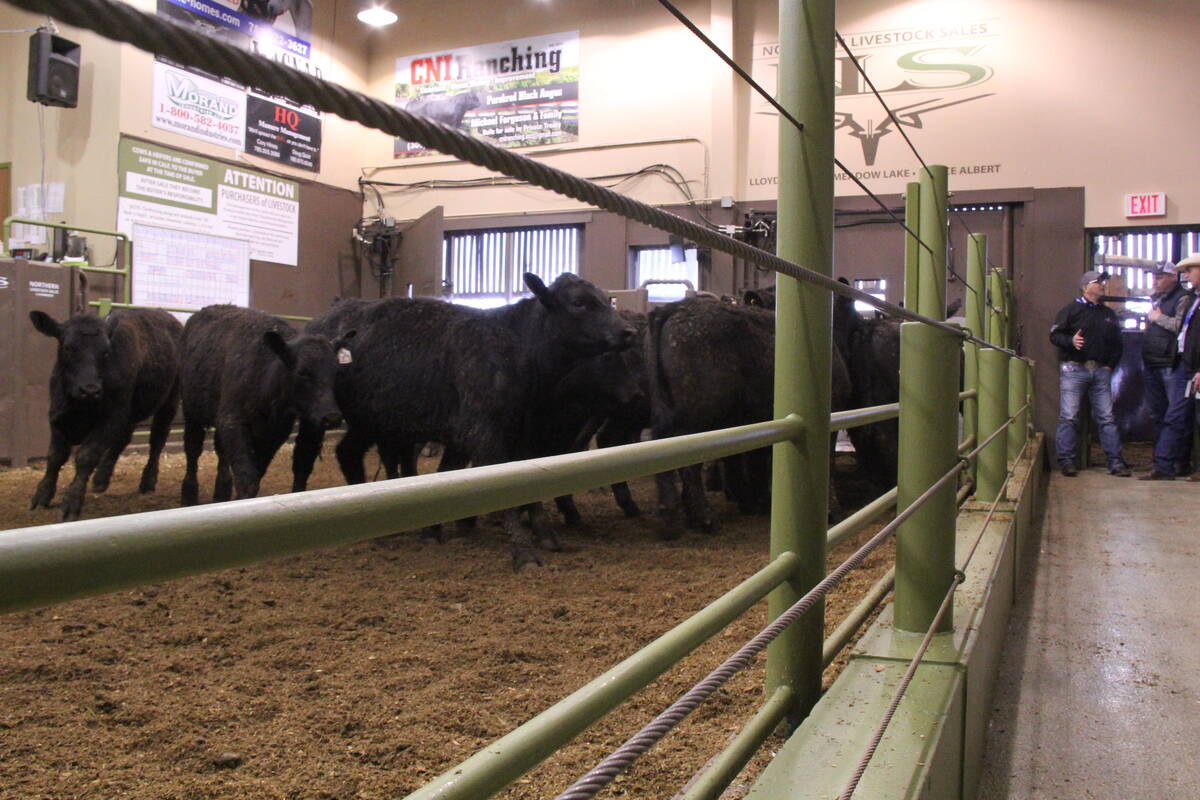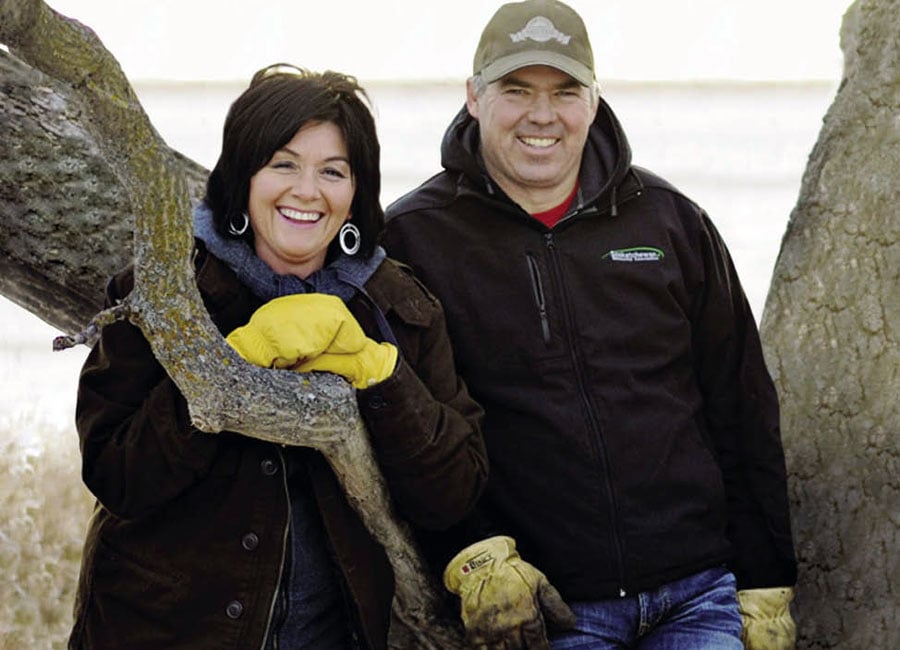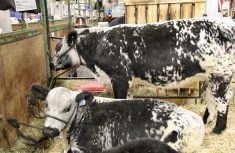Scott and Calla Blair are proud of the family’s roots with the Simmental breed and equally proud of the reputation first-cross (F1) Simmental-Red Angus program they’ve developed to carry their fourth-generation farm near Drake, Sask., into its second century.
Some things haven’t changed since his great-grandfather started out with a typical 160-acre homestead growing grain with a couple of horses for field work and a milk cow or two in the barnyard menagerie. You’ll still find crops, horses and cattle on the Blairswest Land and Cattle operation of today, only in much larger proportions with 6,000 acres of cropland and 300 cows.
Read Also

A change to how the cattle check-off rate is set in Western Canada
On August 1, the Saskatchewan Cattle Association raised the provincial portion of its check-off, raising the total check-off from $4.50…
The herd began to take on a European look in 1970 when Scott’s parents, Dale and Janet, were among the first to import Simmental cattle. That was the start of an era when larger Continental breeds of all kinds made their mark on the Canadian cattle industry. The Blairs liked the size and milking ability of the Simmental cows and the growthy calves.
Showing the Simmentals became part and parcel of farm and family life, but the industry was starting to change by the mid-1990s. The commercial market was looking for more uniformity in the general cow herd with a move to more moderate-type cows and calves with a mix of Continental and British genetics.
Scott and Calla were by then managing the cattle operation and on course to take over the farm. Cattle would definitely remain part of Blairswest’s future.
Scott says he has always liked caring for cattle more than grain farming. Calla grew up on a mixed farm raising cattle, rodeo stock and horses for the family’s PMU operation near McLean, Sask., but says she likes the cattle business, and the people involved in it.
Adding a commercial side to their farm seemed to be a better fit than putting all of their effort into purebreds alone, Calla explains. Growth of their grain operation on top of keeping up with the purebred business was putting a squeeze on their time and labour. They also saw marketing opportunities in the sheer size of the commercial beef industry considering the increasing interest in crossbred females and the market potential of the feeder steers and heifers.
By the early 1990s they were breeding part of the Simmental herd to Red Angus bulls and testing the market by taking their F1 cattle on the road to commercial shows and sales at Western Canadian Agribition in Regina and the Saskatoon Fall Fair.
Scott says it was something of an unusual move for a seedstock producer back then, but there are many more F1s on the market today because they have proven to be great cows. Many of their commercial customers keep crossbreeding simple by buying in F1 replacements and using a third breed as a terminal sire to get an extra boost of hybrid vigour and weaning weight in their three-way-cross calves.
They have seen the weight advantage in the calves from their F1 females bred back Simmental and can attest to the health and longevity often attributed to crossbred females.
After weaning all heifer calves are turned out on stockpiled grass and wintered on hay. Oats are fed to target 1.5 pounds of gain per day.
“We are critical when it comes to selecting heifers because we want a high-quality, uniform product,” Scott says. They consider weight, conformation traits such as udder, feet, legs, and the dam’s track record for the first cut in the spring. The breeding season is 60 days and the second cut takes mainly open heifers at preg. checking in late September.
After weaning in October, the feeder calves are backgrounded on the farm and sold or shipped to a custom feeder just before calving.
The cows swath graze and later graze standing corn up until calving.
More from the Canadian Cattlemen website: Four calving seasons per year spreads out the labour for the family and the bulls
They have a nice setup for winter calving, so they’ve kept to that schedule, starting with the heifers February 10. A new remote camera system in the barn and the family’s hired man of 30 years helps them keep an eye on things.
Their purebred Simmental herd has remained around 200 cows to produce the F1s for their bred heifer market. The rest are Red Angus percentage females bred up from the F1s they’ve kept through the years.
They buy Red Angus bulls from reputable breeders to save running a second purebred herd. A colour-coded dangle tag system works well for quick identification of breed composition.
They routinely sell out of their F1 bred heifers and it’s not unusual to have a waiting list. “The deal is we don’t sell any off the farm before Agribition. We want to take the best ones out and let them sell themselves,” Calla explains. Consistency is the key when putting together groups of cattle for a show, she adds.
The ribbons and banners they’ve won along the way add up, but the real win is the customers they’ve gained through the years showing their Simmental-Red Angus cattle. If they were to pick the year to remember, it might be 2011, when they took home three grand champion titles from Agribition (bred heifers, feeder steers, and open replacement heifers) and were honoured by the Saskatchewan Simmental Association as commercial breeder of the year.
Shows and word of mouth are the extent of their advertising and the F1 bred heifers that don’t go the show route are sold off the farm to buyers across the Prairies and Eastern Canada. They are looking at hosting their own bred heifer sale in the future with a couple of other ranchers who raise F1 females.
A fifth generation
Their plan for the future focuses on management rather than herd size or farm size. “The goal is to keep it simple to get the work done and manage it well,” Calla says.
The future also looks like it will include a fifth generation because the older boys, Cameron and Nolan, have expressed interest in farming and still help out with the cattle and grain operations when they aren’t tied up with post-secondary pursuits, rodeo or junior hockey.
Maguire in Grade 10, is already an old hand at grooming and showing at commercial shows. Last year started off with helping Blairs.Ag Cattle Co. of Lanigan show cattle at the National Western Stock Show in Denver, followed by a summer on the road with 4-H and junior cattle events, including a trip to Olds, Alta., for the Summer Synergy and Calgary Stampede. The black cattle at Blairswest are part of his interest in the club calf (clubby) industry, which is geared toward producing quality prospect steer and heifer calves for junior exhibitors who participate in 4-H and youth shows.
“We will have to ramp up to bring the boys in,” Calla says. That will come with time, though they’ve already been looking at expanding to meet the demand for the F1s and possibly breaking into new markets.
Between the hectic fall schedule and calving in February, January is really the only time they could take a holiday if they wanted to. For now, cattle shows, hockey games and rodeos remain their family holiday destinations.
They are proud that the boys have developed a strong work ethic but for the most part Calla says there’s enough flexibility to work around the other important things in life, and, as they’d say, that’s pretty sweet!

















